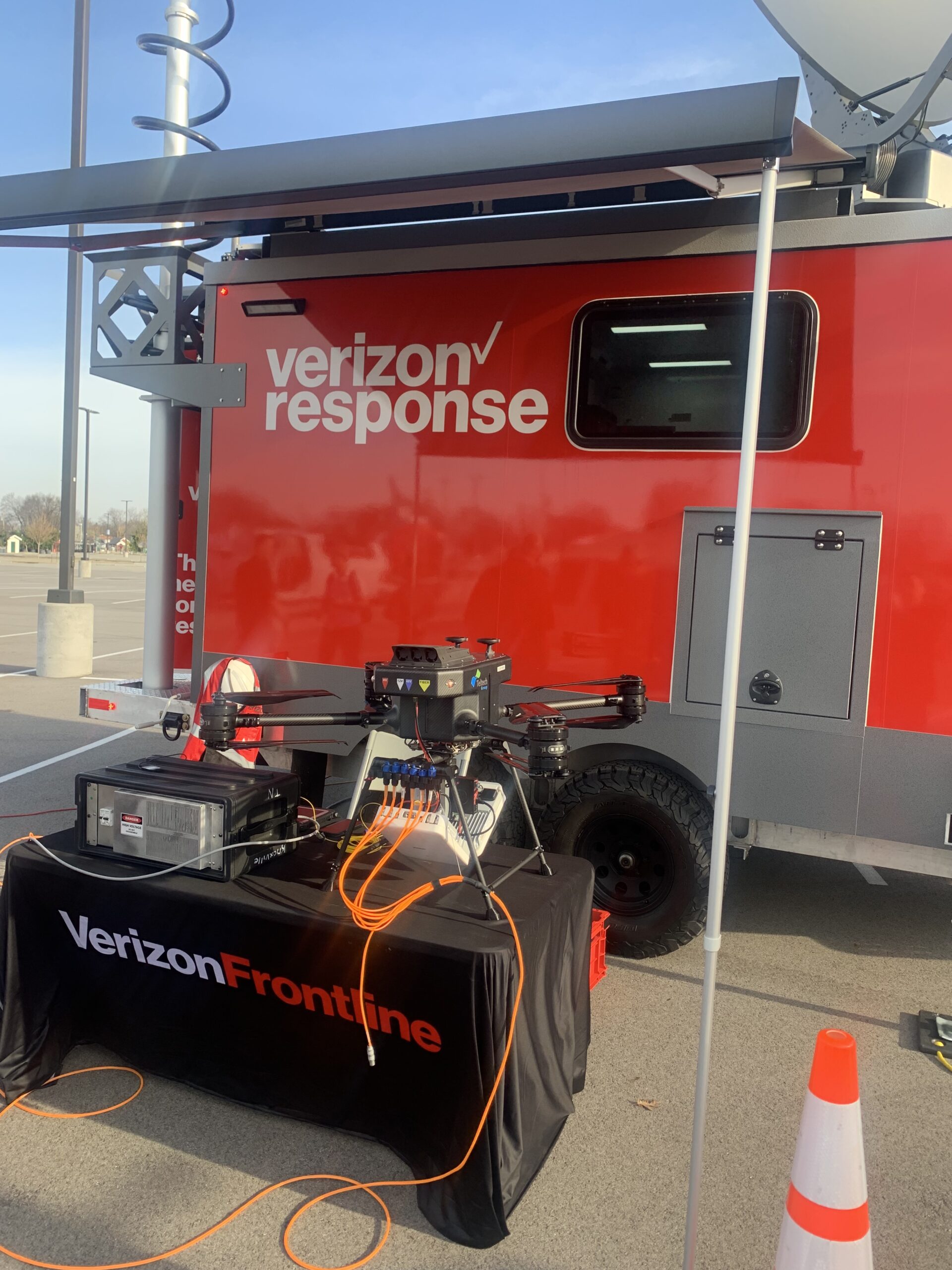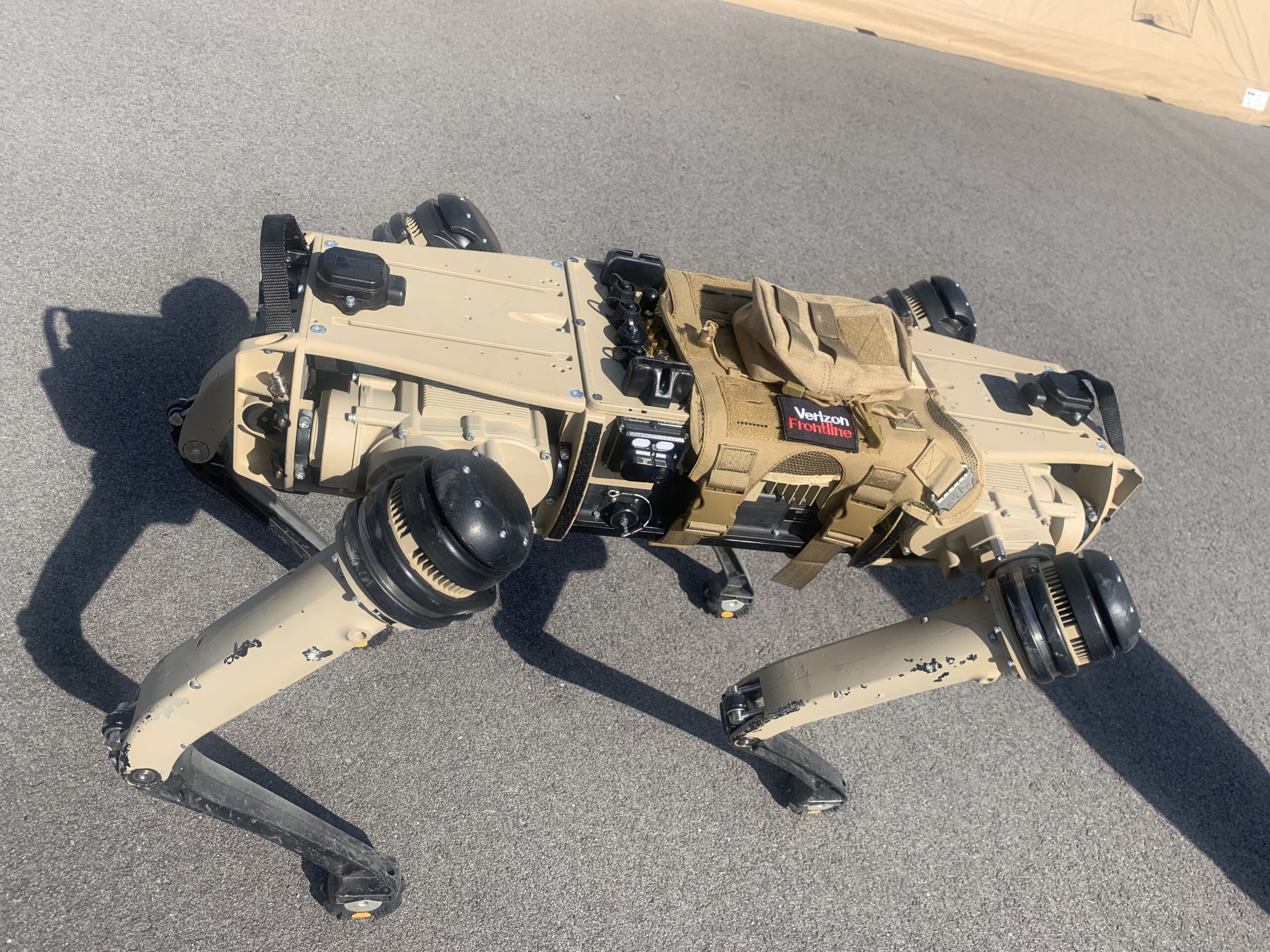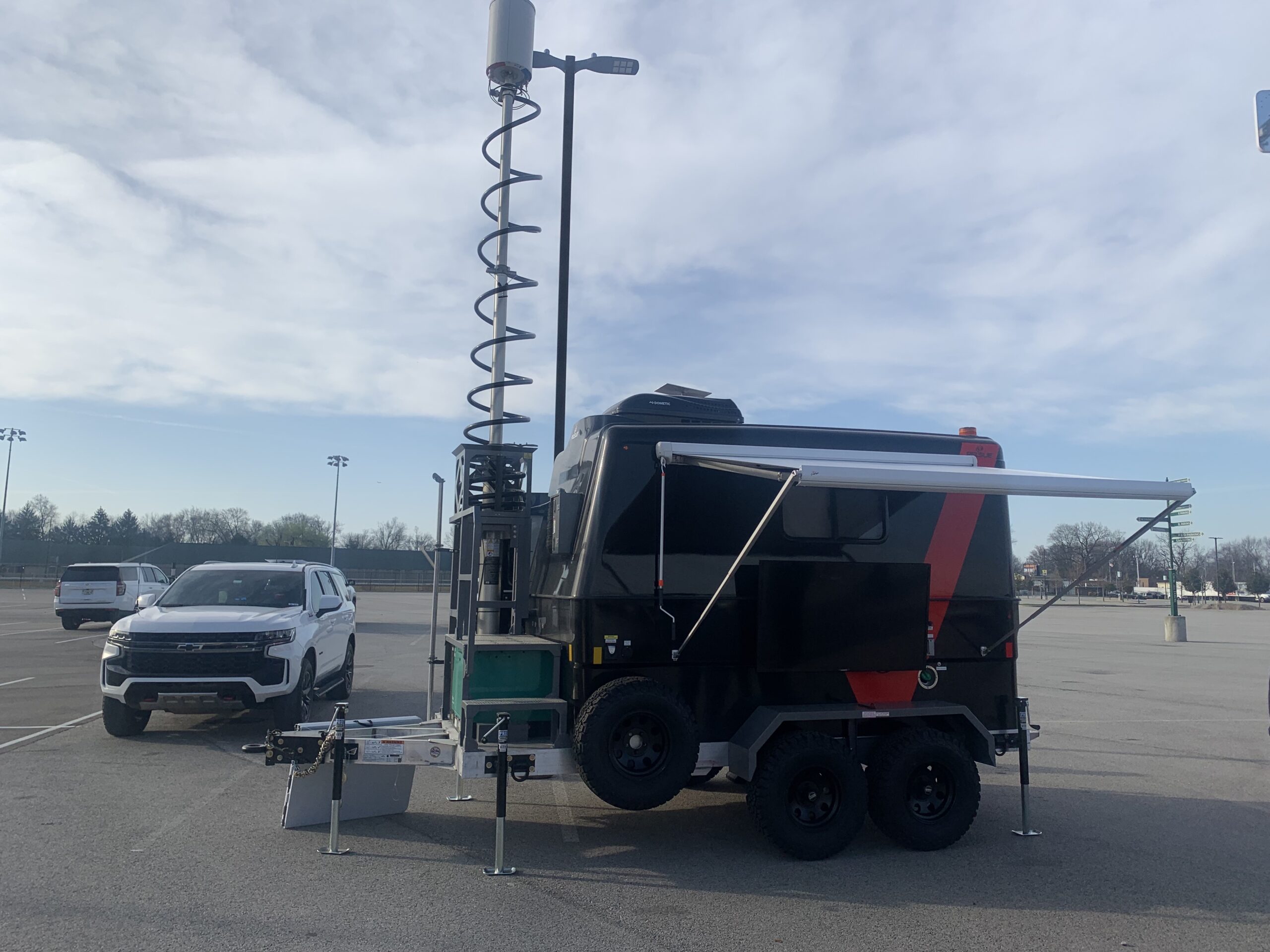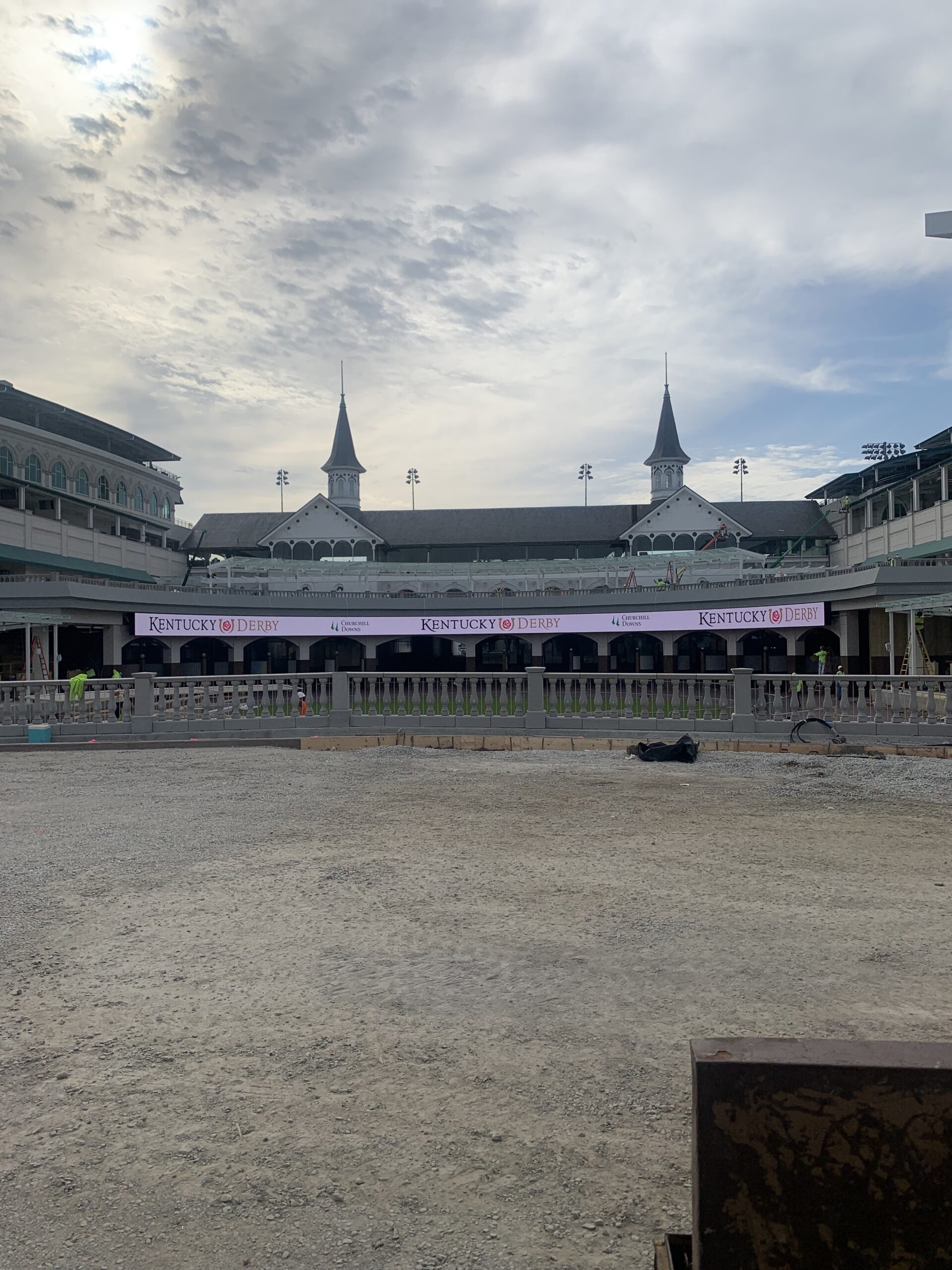Verizon Expands Wireless Capability at Renovated Churchill Downs
More and faster access supports social media, online betting, and first-responders
Story Highlights
In a place that’s all about horses, the Verizon Frontline Response Team will deploy a lot of COWs. When implemented at a venue, including for large-scale sports events, the quickly mobile “cellular on wheels,” or COWs, temporarily supplement a venue’s installed cellular infrastructure to accommodate massive crowds and support the first responders that protect them. In March, Verizon displayed several of the devices at Churchill Downs, where some will be deployed on May 4 for the 150th running of the Kentucky Derby.

A Verizon Response Team Satellite Pico-cell on Trailer (SPOT) temporary mobile connectivity solution provides eFemtos and/or Wi-Fi to emergency-operations centers and first responders,
That milestone is expected to generate unprecedented demand for tickets (limited to 150,000 since 2020), and many — if not most — ticketholders will be devouring broadband by the gigabit, saturating social media with selfies. To accommodate them, Verizon’s response team will further deploy its Rapid Response Connectivity Unit (RRCU), which provides connectivity to specific areas while being able to broayt6dcast secure Wi-Fi and cellular communications.
Verizon’s wireless arsenal comprises the Satellite Pico-cell on Trailer (SPOT), which provides eFemtos and/or Wi-Fi to emergency-operations centers and first responders where connectivity is challenging or nonexistent; an array of cell-equipped drones; a MatSing ball antenna, capable of replacing 14 conventional cell sites; and a Robotic Emergency Dog (RED), one of several Ghost Robotics “dogs” that the Verizon Frontline Innovation Team is using to explore and develop potential mobile-connectivity solutions intended to support first responders.
“The Frontline Team’s job is to keep first responders connected,” says Scott Hansen, associate director, network performance, Verizon. “They’re going to be the first ones on the scene: if, let’s say, a tornado takes out connectivity, they’re going to roll these trucks in, be the first on the ground to restore connectivity for Verizon customers. Even if you’re not [a customer], they will figure out a way to help you out.”
Last year, Verizon significantly expanded its 5G Ultra Wideband service, deployed on its C-band spectrum — the culmination of the 5G C-band spectrum it acquired at an FCC auction — in the Louisville area. The expanded coverage includes Churchill Downs and the downtown KFC YUM! Center, home to the University of Louisville Cardinals men’s and women’s basketball teams. Louisville residents and visitors will be able to use a full 160 MHz of spectrum, nearly doubling the 5G bandwidth previously available in the area. (Verizon won C-Band licenses for the 140-200 MHz spectrum in all available markets and began deploying 60 MHz in the first 46 areas in 2022.)
Hansen adds that the same expanded spectrum and assets will be available for the PGA Championship round at Louisville’s Valhalla Golf Club in May.
Churchill Downs will have access to the expanded 5G coverage during the Kentucky Derby (Saturday, May 4; NBC, Peacock streaming, and Universo in Español), but the track already has 12 cells installed around the venue providing 5G millimeter-wave coverage.
Churchill Downs Doubles Down
The coverage will enhance Churchill Downs’ newly expanded paddock area, which is finishing a three-year-long upgrade estimated at as much as $200 million. It’s intended to bring fans closer to the prerace parade of horses and replace the traditional paddock where the horses are saddled for races.

One of several Ghost Robotics Robotic Emergency Dogs (REDs) tested by the Verizon Frontline Innovation Team in developing mobile-connectivity solutions to support first responders
Although support for emergency services is critical, Hansen says, the need for significantly expanded wireless coverage is driven by social media. To broaden and deepen fan engagement, those channels are increasingly relied on by all sports, but particularly by sports that have seen drops in popularity and attendance in recent years; horseracing, for example, has seen attendance decline 30% since 2000. Strengthening broadband coverage, especially at marquee events like the Derby, buttresses use of social media to promote the sport, says Hansen, who is about to work his tenth Derby race, dating to when 3G was state of the art.
A Bet on Betting
Another dynamic driving the need for expanded spectrum at sports venues is the rapid proliferation of online sports betting. Wagering not only is offered on the outcome of games and races but can become as granular as individual plays and moments, or so-called micro bets. The resulting need for immediacy puts additional strain on cellular networks.
“There are multiple sports-betting apps now,” notes Hansen. “That is a large portion of the internet traffic throughout the day, for sure, and has to be growing every year. Since sports-betting apps have come into existence, [network] demand has gone up, and usage has gone up, which taxes the network throughout the day, especially in that 5:00-7:00 window: there are no races going on, and everybody’s on their phone trying to get their other bets in. That’s why millimeter-wave 5G and C-band have become so important.
“The first year [those apps] came out, their servers crashed,” he continues. “Initially, everybody thought it was the [cell] carriers, but it was actually their servers; there was so much server traffic. They have built that up. We haven’t had any issues in a couple of years, but we can see that IP traffic across the network.”
Monitoring the traffic is via an analysis tool that Verizon has added to the networks, partly in response to spikes in demand caused by social media and online betting: “deep-packet inspection” can analyze data and usage patterns, allowing problems to be anticipated. One consistent issue is that Apple iPhone, which represents the largest mobile-device market share, automatically uploads photos and other content to the iCloud. Thus, uploads, which use more spectrum speed than downloads, are constantly taking place whether or not users are actively using the bandwidth.
Verizon’s regional Frontline Response Team assets, which cover events in Michigan, Indiana, and Kentucky, will be on hand for the NFL Draft in Detroit April 25-27 and the Indianapolis 500 on May 26. But the Kentucky Derby will be the first deployment since Verizon has activated all its auction-acquired spectrum. And it will all be needed, Hansen says.
“From entering the track and inside the track, [Verizon users] covered,” he says. “Everywhere they go, we’ve got individual nodes to offload that capacity. There could be a many as 175,000 people here and in the area on race day, and they’re going to move; they’re going to ebb and flow. They’re going to get out to the track, to the windows, and in the suites. They’re going to move to the outside; then they’re going to go back to the paddock. So we’re covering everywhere: indoor, outdoor, and anywhere around the track. That’s just the nature of how wireless has to be for live sports now.”


